Text
Happy Mixed Martial Arts Day!
(I believe that is the day that follows Boxing Day).
0 notes
Text
And still more of Yellowstone
Back to Yellowstone and the bears.
I don’t know why I was so excited to see bears. I had seen them up very close in Sequoia. And once at Mammoth Ski Resort in California, when we came out to the car, there was a bear blocking the entrance to my door. My friend had to get in and back the car out a safe distance from the bear for me to get in.
Bison should not have excited me at all. What was reputed to at one time have been the largest heard of bison east of the Mississippi was in my hometown. I saw them a lot. Dozens of them in a pen that wasn’t really bit enough for that many massive beasts. And I had seen wolves at the wolf sanctuary in Julian, California. I had seen elk in northern California. I had seen fox when the exterminator accidentally trapped two in my backyard. He was going after the raccoons that were being a menace. I insisted he release the foxes in the yard—my neighbors had seen that pair of foxes with some kits and I didn’t want to orphan their young family.
But there was something about seeing bears and bison in Yellowstone that made it special. Maybe it was that Zach’s excitement had rubbed off on me. He had not seen any of those animals. And the joy of the crowd and being so close to the wildlife was contagious as well.
The momma bear and the other cub started moving laterally along the hillside. I used my binoculars to scan where another crowd of people had assembled a couple hundred yards farther along. I found Zach in that crowd and decided to move over, not only to let him know where I was, but I reasoned I would also have a better angle on the bears from closer to where he was.
The momma bear was moving that direction and I could see her through the bushes. Zach was about 30 feet beyond me. I couldn’t get closer to him without risking slipping down the hill toward the bears, or blocking the view of the many other people assembled to observe the ursine family. Zach said he had a good view of the mother bear, so I handed him my camera with the telephoto attached and he was able to get some shots of her, including her green plastic ear tag while I watched her, as much as I could see of her, through the binoculars. Even though my view was mainly obscured through the bushes, there was something thrilling about seeing something so large and at once threatening and majestic at such close range.
After a few minutes, the mother bear went behind some foliage where no clear view was possible, and although we could see movement that might have been the cubs moving toward their mom, we couldn’t really see them either. I was concerned about how bad the car was blocking traffic, and it wasn’t apparent that we’d ever see the bears again so we decided to move on. There was so much to see and Yellowstone is so large, it was hard to know where to focus the limited time we had.
At another point, we saw a much smaller group of people watching something and we stopped. It turned out there were a couple of wolves. They were across a field and a small stand of water, and it took a lot of explaining from the assembled spectators to be able to find them. As far away as the wolves were, it was exciting to see them knowing they had once been eradicated in the park and now were thriving there.
At first elk were exciting, but soon, like the bison sightings, unless they were doing something particularly interesting, we’d seen enough of them to drive on by. One exception when we saw a group of people lining the edge of the road, all with cameras out, many with tripods or monopods and long lens. An elk was feeding in a field. That would not have been that thrilling to us at this point, but it was the backdrop that made that stop worth it.
Beyond the elk was water and beyond that a mountain, offering a perfect picture—if the elk pulled its head up out of the grass and showed off its huge rack. When it did, the camera shutters were nonstop as we all tried for a shot of the beautiful animal posing as though for an insurance commercial. Zach realized his phone was not going to get a very good photo at this distance, so he just chose to enjoy the moment and let me shoot away with my telephoto. I did get some good shots.
The other time we found the elk particularly interesting was the few we saw at Mammoth Hot Springs. There was a male and two females right near where the crowds assembled to observe and photograph the springs. This part of the springs was interesting because we were basically watching rocks form in real time as the bubbling mass hardened as it churned out of the ground.
The three elk sat by a pillar of rock. The rock itself was interesting. Why didn’t it erode as everything around it had? The ground around the elk was steaming and devoid of life, so clearly was hot and who knows what sort of chemicals were leaching out of the soil. But with so much of the park in which to hang out, we had to wonder why the elk chose this toxic spot so close to people.
(See the last couple of days for the photos to accompany this plog, a continuation of the bears and elk and bison, oh my!)





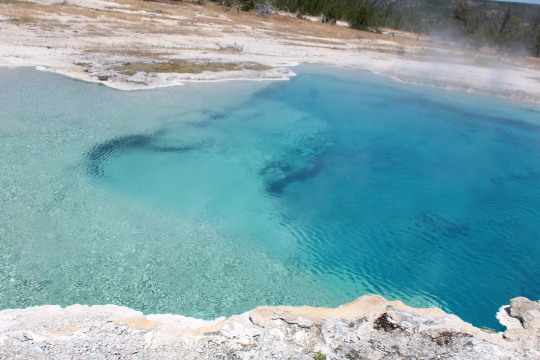

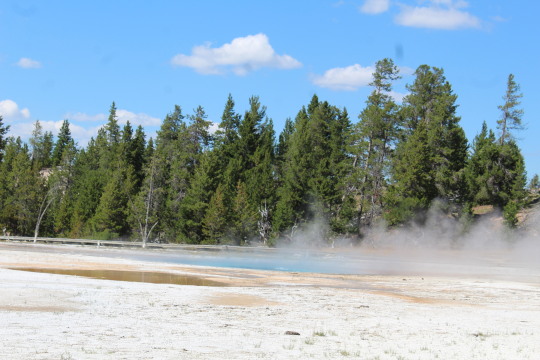
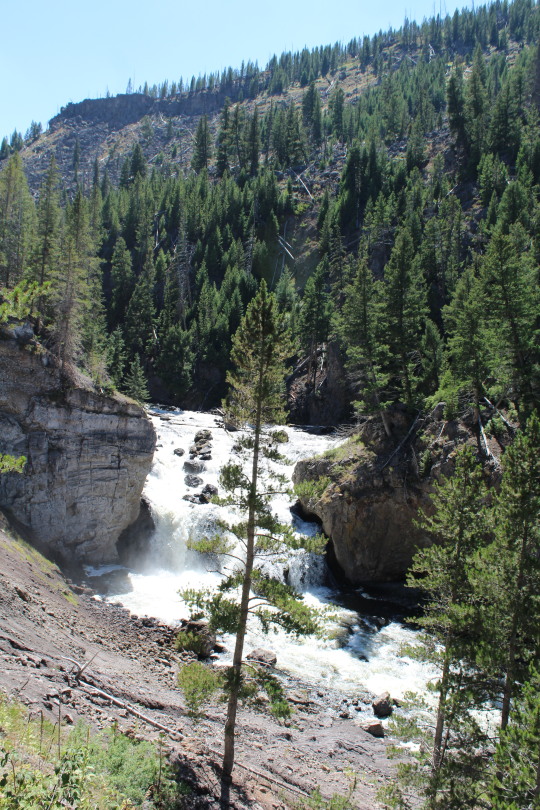
#yellowstone national park#national park#montana#wyoming#travel#adventure#"photography#roadtrip#hiking
0 notes
Text
More of Yellowstone
The bears, and more, continued tomorrow…
As in Zion, we planned to do an initial loop of the park to get oriented then decide on a specific plan, but in Yellowstone, traffic and wildlife and an unannounced road closure made that impossible. We soon realized that we could only plan so much. We knew we could check out the geysers or waterfalls we wanted to. They hadn’t moved in thousands of years, but it was hard to predict when we might get to see a bear.
On one of our first drives through the park, we saw a whole lot of people pulled over and saw two ranger vehicles and their rangers. We knew something must be up. We asked some people and they said indeed—there were bears!
We slowed down a lot—not that we had much choice—but people seemed to be leaving. The bears were moving up a slope and getting lost in the trees. We barely caught a glimpse of them, but figured it wasn’t worth stopping since they were retreating out of view.
We saw lots of bison, including getting stuck in traffic jams caused by them.
Bison, like elk, moose, antelope, and many other herd animals operate on the alpha male system. The biggest, toughest male gets to mate with all the females of the herd while the other guys just get to stand around and dejectedly watch.
That was why the elk congregated near the visitors center—to show off to the chicks.
We did not see any fights although it was rutting season and they could have started a fight at any time. The rangers and other people said there had been some and I had seen the YouTube video from the previous week. There were lots of female elks, but only a few males hanging out around the buildings at Mammoth, but when we were driving away, we saw a large herd of males down the hillside from the buildings. Apparently this was where the males congregated until they sauntered up to where the females were and put on shows of strength to impress the ladies.
As we watched a large herd of bison at a distance, we saw an interesting show of dominance. There were a couple of dozen bison hanging out and one of the males decided it was time to mate with one of the females. He sniffed her and she seemed open to a possible date. Then we saw the beast--a bison so much bigger than the other males that even at our very safe distance, he was intimidating. He strolled over to where the coupling was about to take place and nudged the smaller male as though to say, “You don’t really want to try to make it with one of my harem, do you?”
The young buck seemed to say, yes, yes he did. He turned and squared off with the massive buffalo. They locked heads for only a moment and then the young bull decided better of it and slunk away. The alpha male looked the female over and pretty much decided, eh, not today. He took a few steps back from her, still claiming her as his property, but showed no interest in mounting her. He just wanted to make sure no one else did or dared challenge his authority. I don’t think we saw a bigger bison the whole time we were there. Occasionally, we’d see a male by himself with no other bison around and wondered if he had challenged the king and lost and been banished from the herd. We wondered why he couldn’t just get a female or two of his own and not bother the big guys.
In Grand Teton we saw our first antelope. Even though they show up the song, they seem more African somehow, but there were lots of them in Wyoming. After that first herd in Grand Teton, we saw antelope in Yellowstone, and a few dead ones along the highways in Wyoming. Apparently, they are Wyoming’s counterpart to Pennsylvania’s road-killed deer. Ironic that antelope have a hard time gauging the speed of oncoming Impalas.
The antelope also had an alpha male in their group. When we humans showed up—at a safe distance, but close enough the animals were not unaware of us, the male in who clearly ruled the group, herded the rest of the animals together then stood off to one side as though on guard in case these strange two-legged creatures did pose any kind of threat.
One of the most exciting wildlife encounters we had was with a momma bear and her two cubs. We saw a huge traffic mess. Cars stopped all over the place. Since we were barely (see what I did there?) moving, Zach said he’d jump out and investigate. If it was just more elk or bison, it would not be worth getting involved in the clamor. I kept driving. He didn’t seem to be running to catch up with me and traffic started moving. I finally found a place to pull over about a quarter mile down the road, leaving the rear of the car sticking out into the road, but so had lots of other people.
As I was getting my camera, long lens, and binoculars out of the car, I heard the noise of a decent-sized animal very close. Right across the road from where I parked were two deer. They did not seem the least bit phased by my proximity. I have seen lots of deer in my life. In Pennsylvania they are hooved vermin that eat gardens and run into traffic all the time. I have been close to them in Sequoia, Yosemite, and other parks, but there was something special about seeing them here, in the spectacular haven for wildlife that is Yellowstone.
Now I had a dilemma. Did I stay here and photograph these deer at close range? If I left to seek out Zach and whatever the big deal was down the hill that had attracted all of these people and the animals had left or there was nothing there at all, I’d be disappointed I left the deer. But I decided I’d shoot a few quick deer close-ups and then walk back up the road to where the crowd had congregated. I didn’t see Zach, but I went about 40 yards down the slope to where some people were eagerly watching something. Without looking away from their cameras or phones, the rapt folks told me there were bears. A mother and two cubs.
One thing about all of the places we stopped for wildlife, everyone was very helpful. People quickly pointed out where the bears were last seen, but right now none were visible. At other places, people offered spotting scopes to help us find the animal in question. I also tried to help if I could see the wildlife, and loaned my binoculars to a few people.
Eventually, someone pointed and described where one of the bear cubs was coming out from behind a bush. The cub tried to climb over a downed tree, but failed. While it was trying, I managed to snap a few photos. I am so grateful for digital photography. I used to worry about wasting film, now I could shoot like crazy and if I got nothing but a blur in the bushes, I could delete those later.
That cub went back out of sight, but its sibling emerged about 20 feet to the left. Then someone said the young bear was working its way toward its mother. We could see the bushes moving where the momma bear was coming toward her child. On the trajectories they were on, it was clear the mother and child reunion was going to happen out of sight behind some foliage.
I suggested to the young lady next to me that she go down the hill and flush them out so we could get some good photos of the mother and cub. She wasn’t crazy about the idea, but several people around me jokingly seconded my prompt. She asked why I didn’t go. I told her I would, but I had to take photos. Besides, it might be dangerous. I am glad the assembled audience knew I was teasing and laughed rather than thinking I was serious.
In this situation, and every other wildlife encounter we had, all of the spectators were very cognizant of the rules for staying well away from the animals. We didn’t see anyone approach closer than was safe, even as tempting as it was at time to get better photos of the wolves. There would have been no way to get closer to the goats—they were halfway up a sheer cliff! When the wildlife moved toward people, they moved to give them more space, as when the bison crossed the river then unexpectedly crossed back, the audience that had started toward the river, quickly retreated again toward the road.

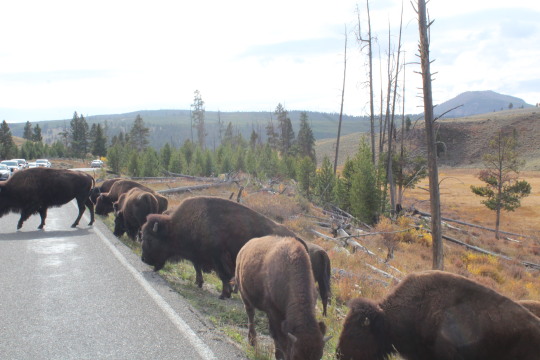
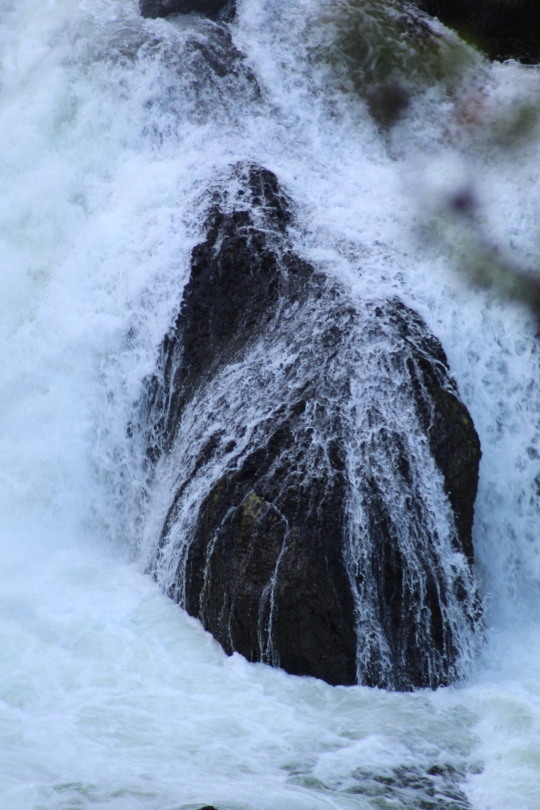
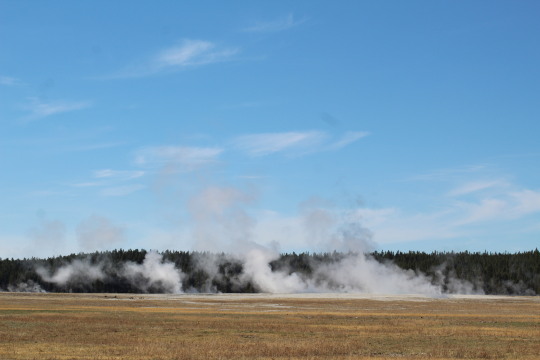


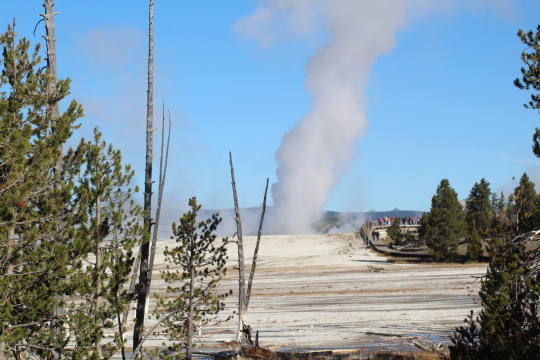

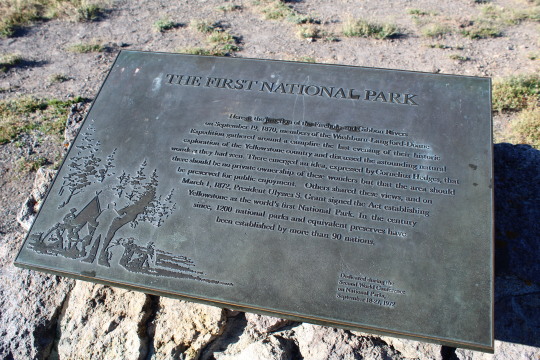
#yellowstone national park#national park#travel#photography#montana#wyoming#hiking#adventure#bears bison
0 notes
Text
More of Yellowstone, and bears, oh my!
As in Zion, we planned to do an initial loop of the park to get oriented then decide on a specific plan, but in Yellowstone, traffic and wildlife and an unannounced road closure made that impossible. We soon realized that we could only plan so much. We knew we could check out the geysers or waterfalls we wanted to. They hadn’t moved in thousands of years, but it was hard to predict when we might get to see a bear.
On one of our first drives through the park, we saw a whole lot of people pulled over and saw two ranger vehicles and their rangers. We knew something must be up. We asked some people and they said indeed—there were bears!
We slowed down a lot—not that we had much choice—but people seemed to be leaving. The bears were moving up a slope and getting lost in the trees. We barely caught a glimpse of them, but figured it wasn’t worth stopping since they were retreating out of view.
We saw lots of bison, including getting stuck in traffic jams caused by them.
Bison, like elk, moose, antelope, and many other herd animals operate on the alpha male system. The biggest, toughest male gets to mate with all the females of the herd while the other guys just get to stand around and dejectedly watch.
That was why the elk congregated near the visitors center—to show off to the chicks.
We did not see any fights although it was rutting season and they could have started a fight at any time. The rangers and other people said there had been some and I had seen the YouTube video from the previous week. There were lots of female elks, but only a few males hanging out around the buildings at Mammoth, but when we were driving away, we saw a large herd of males down the hillside from the buildings. Apparently this was where the males congregated until they sauntered up to where the females were and put on shows of strength to impress the ladies.
As we watched a large herd of bison at a distance, we saw an interesting show of dominance. There were a couple of dozen bison hanging out and one of the males decided it was time to mate with one of the females. He sniffed her and she seemed open to a possible date. Then we saw the beast--a bison so much bigger than the other males that even at our very safe distance, he was intimidating. He strolled over to where the coupling was about to take place and nudged the smaller male as though to say, “You don’t really want to try to make it with one of my harem, do you?”
The young buck seemed to say, yes, yes he did. He turned and squared off with the massive buffalo. They locked heads for only a moment and then the young bull decided better of it and slunk away. The alpha male looked the female over and pretty much decided, eh, not today. He took a few steps back from her, still claiming her as his property, but showed no interest in mounting her. He just wanted to make sure no one else did or dared challenge his authority. I don’t think we saw a bigger bison the whole time we were there. Occasionally, we’d see a male by himself with no other bison around and wondered if he had challenged the king and lost and been banished from the herd. We wondered why he couldn’t just get a female or two of his own and not bother the big guys.
In Grand Teton we saw our first antelope. Even though they show up the song, they seem more African somehow, but there were lots of them in Wyoming. After that first herd in Grand Teton, we saw antelope in Yellowstone, and a few dead ones along the highways in Wyoming. Apparently, they are Wyoming’s counterpart to Pennsylvania’s road-killed deer. Ironic that antelope have a hard time gauging the speed of oncoming Impalas.
The antelope also had an alpha male in their group. When we humans showed up—at a safe distance, but close enough the animals were not unaware of us, the male in who clearly ruled the group, herded the rest of the animals together then stood off to one side as though on guard in case these strange two-legged creatures did pose any kind of threat.
One of the most exciting wildlife encounters we had was with a momma bear and her two cubs. We saw a huge traffic mess. Cars stopped all over the place. Since we were barely (see what I did there?) moving, Zach said he’d jump out and investigate. If it was just more elk or bison, it would not be worth getting involved in the clamor. I kept driving. He didn’t seem to be running to catch up with me and traffic started moving. I finally found a place to pull over about a quarter mile down the road, leaving the rear of the car sticking out into the road, but so had lots of other people.
As I was getting my camera, long lens, and binoculars out of the car, I heard the noise of a decent-sized animal very close. Right across the road from where I parked were two deer. They did not seem the least bit phased by my proximity. I have seen lots of deer in my life. In Pennsylvania they are hooved vermin that eat gardens and run into traffic all the time. I have been close to them in Sequoia, Yosemite, and other parks, but there was something special about seeing them here, in the spectacular haven for wildlife that is Yellowstone.
Now I had a dilemma. Did I stay here and photograph these deer at close range? If I left to seek out Zach and whatever the big deal was down the hill that had attracted all of these people and the animals had left or there was nothing there at all, I’d be disappointed I left the deer. But I decided I’d shoot a few quick deer close-ups and then walk back up the road to where the crowd had congregated. I didn’t see Zach, but I went about 40 yards down the slope to where some people were eagerly watching something. Without looking away from their cameras or phones, the rapt folks told me there were bears. A mother and two cubs.
One thing about all of the places we stopped for wildlife, everyone was very helpful. People quickly pointed out where the bears were last seen, but right now none were visible. At other places, people offered spotting scopes to help us find the animal in question. I also tried to help if I could see the wildlife, and loaned my binoculars to a few people.
Eventually, someone pointed and described where one of the bear cubs was coming out from behind a bush. The cub tried to climb over a downed tree, but failed. While it was trying, I managed to snap a few photos. I am so grateful for digital photography. I used to worry about wasting film, now I could shoot like crazy and if I got nothing but a blur in the bushes, I could delete those later.
That cub went back out of sight, but its sibling emerged about 20 feet to the left. Then someone said the young bear was working its way toward its mother. We could see the bushes moving where the momma bear was coming toward her child. On the trajectories they were on, it was clear the mother and child reunion was going to happen out of sight behind some foliage.
I suggested to the young lady next to me that she go down the hill and flush them out so we could get some good photos of the mother and cub. She wasn’t crazy about the idea, but several people around me jokingly seconded my prompt. She asked why I didn’t go. I told her I would, but I had to take photos. Besides, it might be dangerous. I am glad the assembled audience knew I was teasing and laughed rather than thinking I was serious.
In this situation, and every other wildlife encounter we had, all of the spectators were very cognizant of the rules for staying well away from the animals. We didn’t see anyone approach closer than was safe, even as tempting as it was at time to get better photos of the wolves. There would have been no way to get closer to the goats—they were halfway up a sheer cliff! When the wildlife moved toward people, they moved to give them more space, as when the bison crossed the river then unexpectedly crossed back, the audience that had started toward the river, quickly retreated again toward the road.
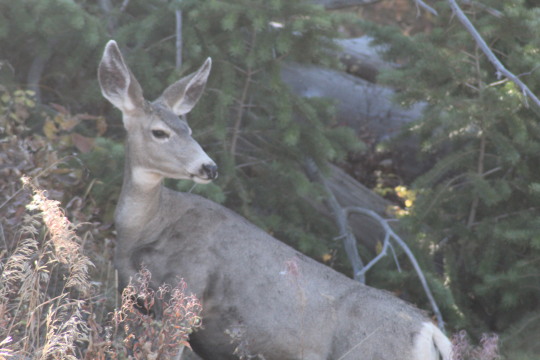
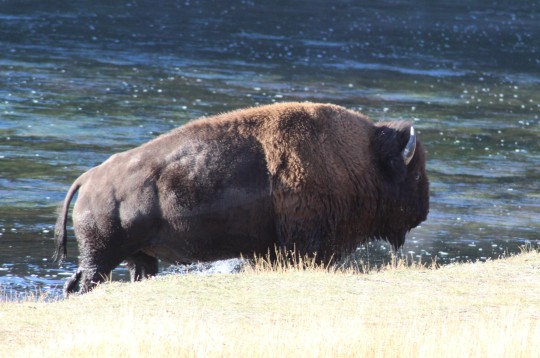


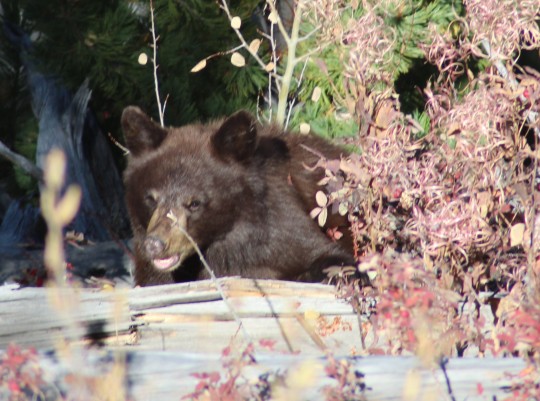
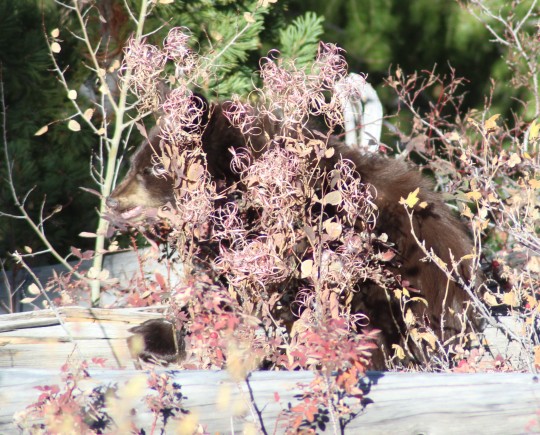


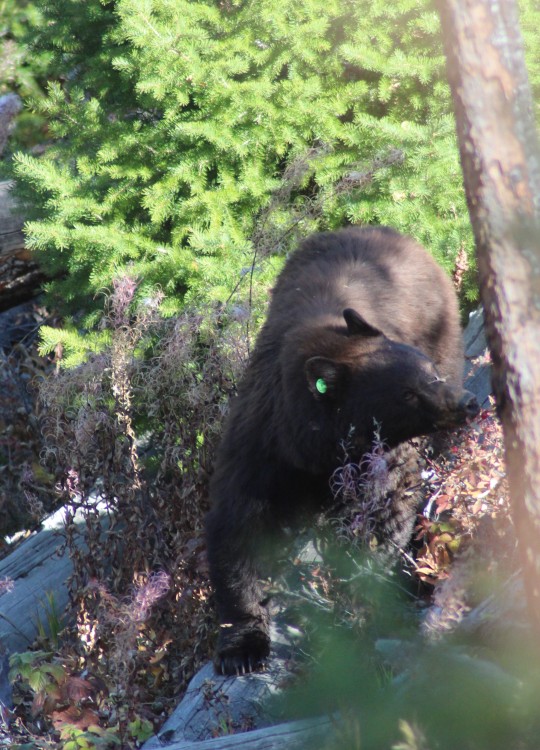

1 note
·
View note
Text
Yellowstone Day 1
The wildlife in the parks…
We saw our first fox as we were looking for our lodging in West Yellowstone. But in the dark, it wasn’t possible to get a good look or a good photo of him before he disappeared.
The first good view and photos we got of a fox were right after we entered Grand Teton. He was hanging by the stables near one of the visitors centers. Later saw one near the gas station where we had stopped to use the restroom (which was closed). The fox seemed very unafraid and came so close to the car, I thought he might hop in and want to go for a ride. I left the car door open in case I had to jump inside for safety. But I got some nice photos of him. He, too, seemed to be seeking a restroom.
In Yellowstone, we visited a stream that the ranger had said was gathering spot for moose, but once again none materialized so we took a little hike up the creek side through a campground that was now closed for the season. When we came back to the creek, we asked an older couple about moose and they said they hadn’t seen any, but had been watching mountain goats. They pointed out a small waterfall coming of a mountain a ways away and near it were two mountain goats. Through the telephoto lens and binoculars, we could tell they were goats as the bounded the cliff face, landing on slivers of rock ledges that seemed too small to hold anything that large. In the photos they were just white dots, but it was cool to see them and add another animal to the list of wildlife we encountered.
That Yellowstone ranger inside the visitors center was like a kid explaining where to see wildlife and it was great to see his enthusiasm still so vibrant after years on the job. He was eager to talk about bears and bison, give us suggestions and safety tips for seeing bears, all without sounding at all bored although I’m sure he answers these same questions dozens of times a day.
We encountered a few burnt-out rangers. In Zion, the ranger on duty near the trail for Angel Falls was clearly annoyed that we asked where the trailhead was. We had just stepped away from her table when we heard more people ask the same question and get the same exasperated answer. We found lots of other trails with signage, and wondered why they didn’t post a sign here instead of wasting the time of a human being who was sick of repeating the same response.
The ranger near Lake Yellowstone answered my questions politely enough, but when the subject of people interacting with animals came up, she sighed, lamenting that so much of her job was people control. She. She said their problem isn’t wildlife control, it is people control. I had asked her if rangers are dispatched when a potentially dangerous wildlife encounter occurs.
What prompted my question was seeing the crowd that had gathered to see some bears near the road. At least two rangers and two ranger vehicles were on hand and suddenly the crowd seemed to disperse and I wondered if the rangers had been summoned to handle the situation and they had chased the crowd away. She said they don’t do that. I asked if they ever used bear spray or an airhorn to shoo the wildlife away and she said, no, that if the situation became too dangerous, they would have gotten rid of the crowd, not the bears.
While I was talking to her, an older couple approached and asked what bird was making the interesting sound. The ranger shrugged, “Sorry, I don’t really know birds.”
I told her about the bison traffic jam and the guy in the Buick who seemed to be challenging the herd to force his way through, only to be stopped by a bison who was having none of it and launched a bluff charge at the car. As the guy in the Buick passed us, he said to Zach, “I guess it’s not a good day to be driving a red car.”
The ranger said the color of the car had nothing to do with it. The man driving into the herd is what provoked the bison to charge. They will defend their herd and will do serious damage to a car. The ranger said if there is a particular color car that upsets bison, it is white because that’s the color of the rangers’ vehicles which often tend to show up to break up bison traffic jams. We learned that “bison” is just the more technical name for buffalo, but they are the same animal.
Rangers were always standing by to keep people away from the elk who had decided to camp around the Mammoth visitors center and lodgings. I asked a ranger about video I saw on YouTube of a rutting male elk suddenly breaking off his fight with another male to suddenly charge a tourist, who along with many others was taking photos. Did the man do something to provoke the attack? The ranger said no. Some male elk take it upon themselves to attack a random target—a person, a car, a mailbox—to show prospective mates or competitors that they are aren’t afraid to take on any threat. It is just a random show of strength like a drunk guy in a bar punching a wall to show how tough he is.
I asked why the elk congregate around areas that are so full of people and cars when they have 3500 square miles in which to roam—and that is just the park—they clearly can leave the park if they want. The elk that hang out in the visitors’ area are looking for handouts. For years the park authorities fed the elk to entertain tourists. That practice was curtailed decades ago, and it is illegal for anyone to feed the wildlife now, but these elk have apparently had it passed down to them from generation to generation that this is a good place to hang out for free food and sexual partners.
In talking to rangers and doing some research online, I learned that elk account for the more than any other animal each year in the park. But they have never killed a human. They certainly could, but seem content to stop at goring and trampling.
The wolves, reintroduced to Yellowstone amid much controversy about 25 years ago, have never attacked a human in the park.
There are about 700 grizzly bears in the park and they, along with their smaller and somewhat less deadly cousins, the black bear, which now number about 600, combined have only killed eight people since the park opened in 1872. Of course, there have been many more non-fatal attacks, but really not that many of those given how stupid people can be around wildlife. Check out some of the videos online of people trying to take selfies with bears.
Surprisingly, the animal that has killed the most humans in the park is the moose. Given that there are only 150 of them—far fewer than wolves, bear, bison, or elk--that the moose would be the deadliest creature was not something I would have guessed. Part of that is due to the fact that even stupid people assume bears and wolves are dangerous—just look at those claws and teeth!—but moose look slow and stupid and kinda cute, like Bullwinkle, and people want a selfie with them.
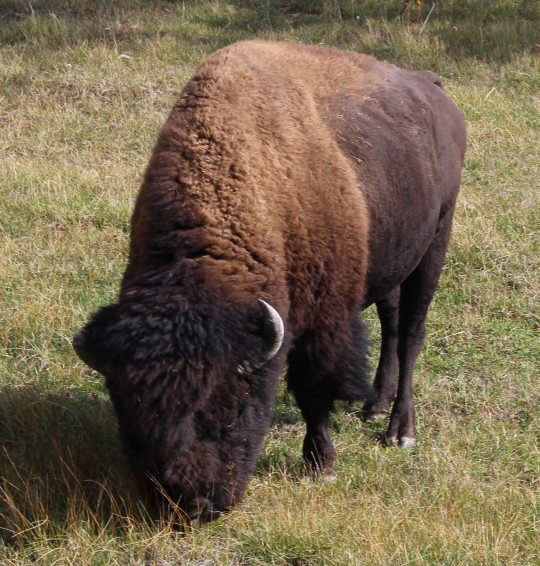

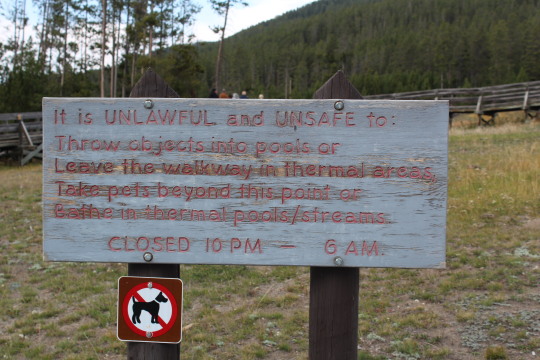

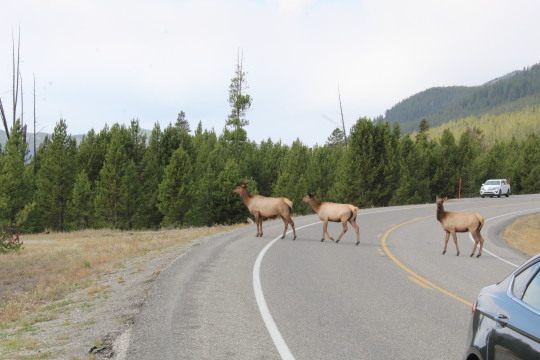

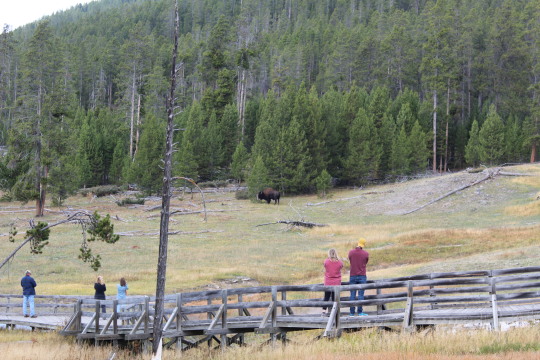

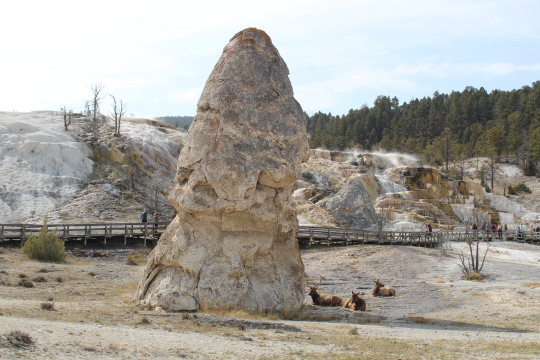
0 notes
Text
From Zion to Idaho
More on last year’s road trip...
We had been warned that snow can hit Yellowstone by late September, but the weather could not have been more ideal. In Zion, and even in Yellowstone and Petrified Forest, there were days of shirtless hiking. Most days when we woke up in West Yellowstone, Montana, the temperature was in the low 20s. By the time we got into Yellowstone National Park, it was in the 30s. By the time we found a spot for our picnic lunch, it was 70.
We waited until just a few weeks before our trip to start booking places to stay. We had to make sure we could both take the time away, but that meant we didn’t have a lot of selection left in our price range. That is how we got stuck so far from Zion in the crappy motel in St. George. But it also meant we lucked into a great spot near Yellowstone.
I didn’t even realize we were staying in Montana, not Idaho. I had never looked at a map that carefully to see that Montana and Wyoming don’t share a straight border all the way across. A little piece of Montana dips down between Wyoming and Idaho. I also didn’t realize when I booked the place how close it was to the park entrance—less than two miles.
The place was small, but had a little kitchenette and so we could keep food to take in the cooler for lunches and have breakfast and even some dinners in. There isn’t much to the town of West Yellowstone and one evening while doing laundry, we walked almost the entire village. Not much to see other than a lot of tourist shops.
It was quick getting into Yellowstone National Park. Not nearly as quick getting around in the park. There is basically one road that loops the entire park. Part of that loop was already closed for the winter (although there was not a snowflake in sight), so we could only cover about 80 percent of the loop. About 10 days after we left, another chunk of road was scheduled to be closed for the winter. And indeed, I saw on the Weather Channel the first snow of the season had hit the week after our visit.
You best not be in a hurry to drive anywhere within the park. We wondered if park employees used the same excuse every day for being late—I got stuck in traffic. The one park road is one lane in each direction, which means if you get stuck behind a driver (often in an RV) doing 10 mph, you will be doing 10 for quite a while. Few of these drivers seemed inclined to use turnouts to let traffic pass. Luckily there is amazing scenery all around so all you can do is take the time to admire the park.
The main source of traffic jams in the park is wildlife. Several people had told me about this. If you see a bunch of cars stopped, you may want to stop, too, there is likely something to see. At first, we were excited to see elk or bison and had to stop for photos, but after a while we became jaded—the big things were everywhere. We had to stop a few times for bison in the road. After a while we only wanted to stop for elk and bison for the possibility of a close-up photo or a picture with a great backdrop. We were lucky to get those. Other than that, we didn’t stop for just a random elk or bison far out in a field. It was only the new tourists who would do that. But we would stop for something really exciting—bears and wolves!
The signs and rangers advise staying at least 100 feet from buffalo and elk and farther from bears and wolves , but that is tough to do when you are stuck in traffic and a buffalo walks to within three feet of the car window. I could have petted him, but thought better of it.
According to the nice ranger we talked to at the Mammoth Hot Springs visitors center, there are 15,000 elk in Yellowstone and only 150 moose. Apparently, there are more mooses (meese?) in Grand Teton and Jackson Hole, but we didn’t see any there. Yellowstone is home to almost 5000 bison, which is pretty amazing considering they were almost made extinct there only a few decades ago.
According to the rangers, moose kill far more people in the park than bears do. Elk have never killed anyone in the park, but do gore and trample guests so still can be quite dangerous. There has never been a human attacked by a wolf in Yellowstone. Of course, the most dangerous beast in the park, killing and wounding more than all others combined, are Cougars, Bison, Impalas and other makes of automobiles.
We got quite lucky with wildlife sightings and got some good photos (and less good photos of things we had to photograph at a distance—wolves and mountain goats), but got shots of bears, elk, antelope, deer, bison, and fox. Of the larger animals we wanted to see, we only missed meese, bighorn sheep, and martens. The photos we got of bears and elk and antelope may look like we were dangerously close, but those pictures were taken through my telephoto lens so were not within striking distance of the large animals. But it was a thrill to see a mother and her cubs so close.
Another great experience was getting to hear an elk bugle. That is what they call the sound an elk makes. It is surprisingly to hear the noise because you’d think something that big would bellow or roar, or might sound like a brass instrument in a marching band, but it actually sounds like a really annoyed baby crying.
We saw buffalo farting. The air was cold enough we could see the little puffs as they raised their tails. Why we found this so amusing other than never having outgrown junior high school, it’s hard to say.
We saw lots of buffalo roaming, and saw lots of antelope and many deer, but I never saw them playing together so I am beginning to doubt that the deer and antelope actually do play together. We did seldom hear a discouraging word and the weather was great, so the skies were not cloudy all day.
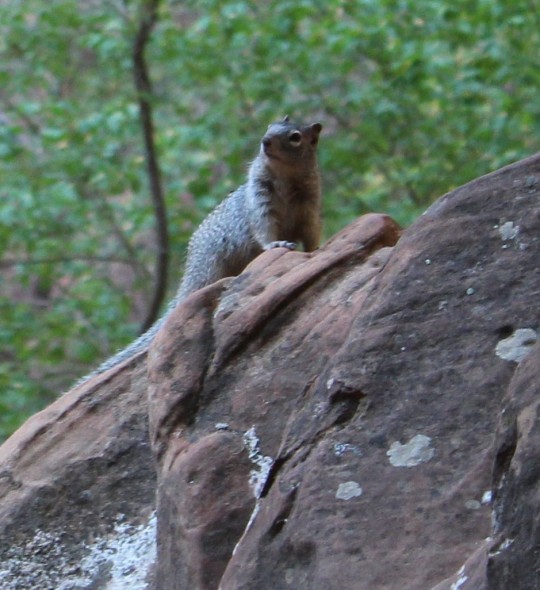
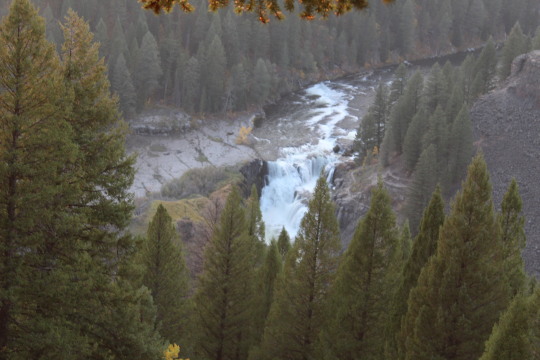

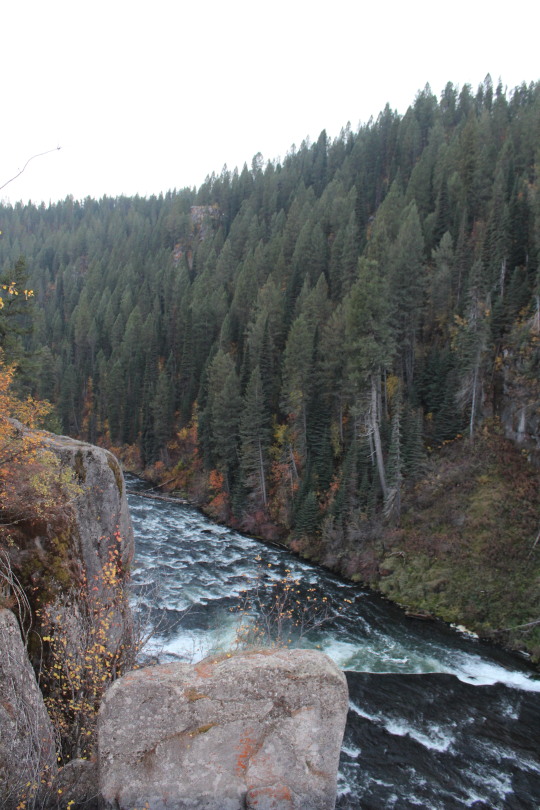

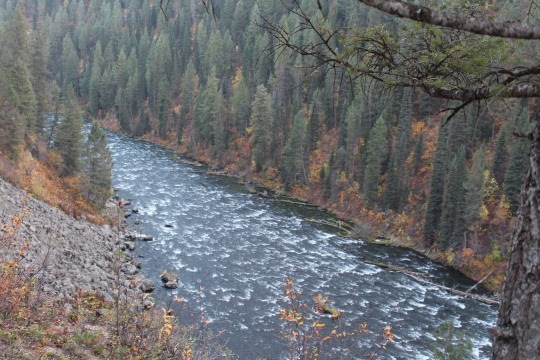
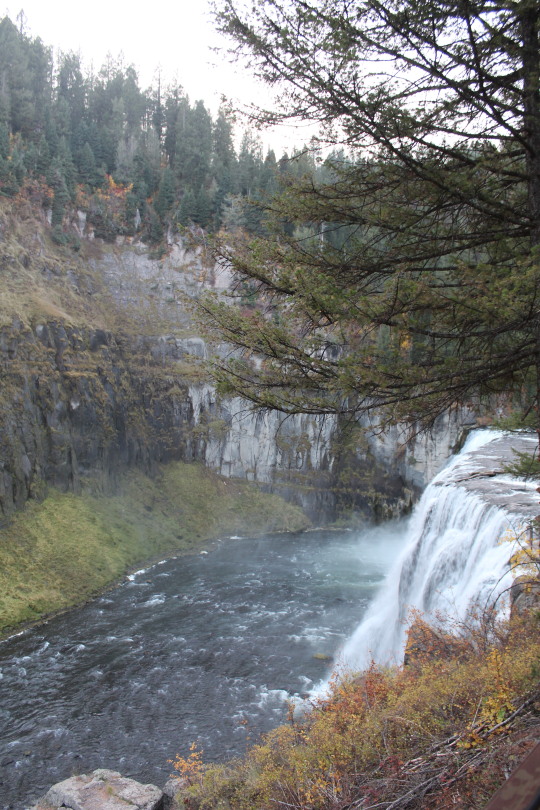
#zion national park#yellowstone national park#Utah#montana#roadtrip#travel#adventure#photography#hiking
0 notes
Text
More of Zion National Park
After conquering Angels Landing and living to tell the tale, Zach was ready to hike the trail to the Emerald Pools. Like many parts of Zion, the signage was lacking. In fact, the entire national park system could use better signs. We especially noticed this in Yellowstone where the park map we got at the ranger station showed some point of interest that looked interesting, but then there would be no sign for the Virginia Cascade and we’d see a sign that we were crossing the Gibbon River and realize we had just missed the cascade turnoff. Many points of interest only had signs for one direction of traffic. For instance, we wanted to check out Wraith Falls, but there was no sign. Coming back that same route from the opposite direction, there was a sign for the turnoff to the falls.
Wraith was probably the most disappointing of all the falls we saw in Yellowstone, but we enjoyed the walk—it was one of the few trails with almost no people. It was nice to have a bit of the park to ourselves as when we hiked up beyond the Pebble Creek campground and could be alone with the stream. Of course, numerous signs warned about going too far afield except in groups of three or more due the dangers of bears. But more on that when we get to Yellowstone.
So there was lots of guesswork to finding the Emerald Pools in Zion. And lots of asking other people coming the other way, “Is this the way to the pools?” and being asked that a lot by other people, even though we were ignorant of the geography as well.
The first couple of pools and the one little waterfall were not very impressive or worth the climb, although some other visitors said the falls were better earlier in the year. It had now been pretty dry for a few months. And the pools didn’t look any special color, certainly not emerald. Although it was nice, we weren’t quite getting the attraction and were wondering about expending all this energy for a hike over lots of rocks and tree roots.
Then we got to the third emerald pool. And it truly was emerald and very pretty and coupled with the other sights along the way, made it worth the trek.
There were other little waterfalls and interesting rocks and trees along the way. It was difficult at times to know what to photograph. You could almost point the camera a random direction and get a spectacular shot of rock formations or beautiful trees.
The geology of so many of these places was amazing. I did take a geology course in college—Gsci 20, Rocks for Jocks—and can still remember parts of it which came in handy on this trip, but I wish I had remembered a lot more. Truth be told, I still can’t tell schist from Shinola.
We were also fortunate that the weather was so perfect. Blue skies that made for a nice backdrop for the photos of the mountains and warm enough for just shorts and T-shirts.
After Zion, it was on to West Yellowstone, Montana.
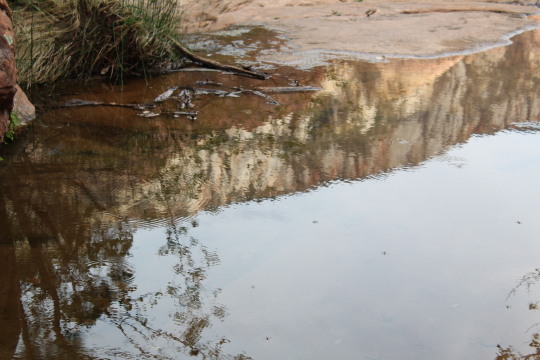
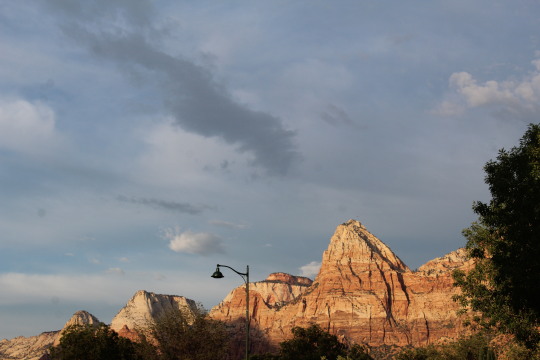


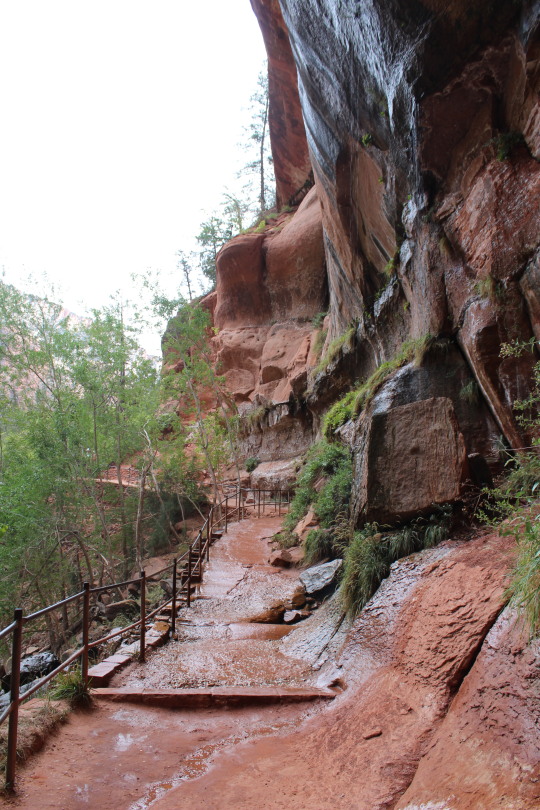
0 notes
Text
More of the trip to Zion NP
Day two in Zion, Zach was determined to conquer Angels Landing. I had heard about this climb from several people and knew I would not make it to the top. Even people with much less of a fear of heights or are who in better shape than I am, have given up. It is quite the ascent.
Angels Landing is one of the most famous hiking challenges in any national park. It is a 5-mile roundtrip up a 1500-foot gain to the top of an overlook with a spectacular view of most of the main valley of the park. But the last part of the trail is across a rock ledge that has only a flimsy chain for a handhold. Many hikers brave the strenuous climb to that last section, only to give up before crossing that last dangerous section with steep drop offs to certain death on both sides.
The sign at the bottom of the trail warns that 13 people (what a lucky number!) have fallen to their deaths since 2000. Just in case you needed a reminder of the risk you’re taking. Like all of the messages of animal attacks in Yellowstone, the danger is real, although they may over-emphasize it to keep people cautious.
Angels Landing was named in 1920 by a minister who thought you were so close to heaven up there, that you could commune with angels.
I made it about a third of the way to Angels Landing, then opted to sit in the shade and write and reflect while Zach went on up. All of life is a trade-off. I didn’t want to spend too much time journaling and plogging while on the trip or sorting photos as I took them instead of enjoying the parks and the break from devices and social media, but I very much enjoyed the time to sit and write.
Another trade off: I had decided the cost to me of going farther—to my knees and legs and being too worn out for any other hiking that day wasn’t worth it. I was not going to enjoy the next section of the trail with its steep drop-offs and I wasn’t going to make it to the very top anyway.
I am glad I did stop so I had the energy to keep up with Zach when we visited all three of the Emerald Pools later in the day. And then having to walk back to the car after we missed getting off at the shuttle stop for the car.
I found one of the few shady side-niches in which to sit and write. Many people said hello as they passed. Others stopped to rest here one of the few areas where that was possible until much farther along the trail. I enjoyed these little interactions as well as snippets of overheard conversations.
One guy said to his companions, “The only other way down is in a body bag.”
I found it interesting how differently people dressed to ascend Angels Landing. Some looked like they were prepared to summit Everest or K2 with all the equipment they are wearing and carrying. Some seem properly and proportionately attired with walking sticks, a Camelbak, shorts, hat, hiking boots. Others were dressed for a quick trip to 7-11—a light dress, sandals, no hat, or water. Some are huffing and puffing in this stretch, long before they have really started to climb. Others are literally running the whole way.
A woman named Aliah asked what I was writing (as did many others passing by) and she said, to make sure to include Aliah in what I was writing.
A couple, each about 45 years old passed by. She was wearing a mask and said to her husband, “Okay, we can go back down now.” He never looked back or responded and just kept walking in front of her. She just followed.
Several people who passed me on the way up came back by on the way down, but clearly didn’t have time to make it to the top and must have given up farther along the trail. A few of these people said they had made it all the way up, but given how fast Zach hikes, I was sure he would be down before them if they passed me on the way up an hour after he left me.
I asked a guy how he was doing, and he replied, “Better than I deserve.”
There was a woman wheeling a travel suitcase—a carry-on bag--all the way up and down the trail.
A couple came up blasting music. It seems criminal and selfish to ruin the silence with that. You can listen to music anywhere or use earbuds.
A couple stopped near me and were speaking French, so I said, “Ca va.” We struck up a conversation. They were actually French-speaking Belgians. They had been in Florida for 6 months studying to be pilots. They had 6 days off and had flown to Vegas, hit Death Valley, the Grand Canyon, and Bryce, had one day in Zion before going back to Vegas to see Sin City for one day before they returned to Florida.
One guy, about 60 years old, by himself, was swaying, delirious, almost veering off the trail. I was tempted to go help him. But he staggered down around the next switchback.
Parents and a girl who was about age 15 stopped at my little shaded rest area. Unlike the others who stopped, they never spoke to me or even nodded hello. The Dad was concerned that the altitude and the girl’s allergies were getting to her. The girl asked her mom for a Kleenex. Mom put down her pack, pulled one out and angrily handed it to the girl without a word. The girl blew her nose in it and asked for another. The mother thrust another one at the girl. The father resumed walking. The woman resumed walking, trailed by the girl. The teenager said, “I’m sorry, my allergies are really bothering me.” Without looking back, the mother said, “Yeah” and kept walking. If the girl was really suffering, the parents seemed cruel for dragging her along on this trip. She might have been faking or exaggerating. Either way, it looked like a miserable family trip.
There would several minutes at a time with no one passing when I could be alone with my thoughts.
When I put on my long lens to get some shots of the people way up on Walter’s Wiggles, a squirrel tried to get at the pretzels in my backpack. Yelling at him didn’t even phase him, nor did throwing a twig at him.
While I was writing this, I heard the WHUMP! WHUMP! WHUMP! of large wings and looked up to see a large bird—a hawk or eagle or vulture—fly up and land on a rock ledge about 75 yards beyond me. Might be its nest.
Another thought I had to reflect on—instead of being discouraged that I couldn’t do as much hiking as Zach and go all the way up Walter’s Wiggles to Angels Landing, I should be grateful that I can still visit national parks and can hike as far as I can. I know too many people my age or younger who can’t even hike this much or who don’t have the freedom to get away like this.
And yes, the complicated, tangled switchback that was the majority of the ascent is called “Walter’s Wiggles.” Sadly, they are not named for me, but for Walter Ruesch, the park superintendent who had those switchbacks constructed in 1926.
Zach and I had agreed that if after three hours he had not returned, we’d meet in the picnic area near the restrooms we had used before setting off up the trail, in case he somehow missed me as he came back down. We figured it was hard to miss the restrooms. We always had a backup plan since we had no cell service to connect when we separated.
I followed the plan and went to the picnic area to continue writing. While I was waiting, I looked up to see that a flock of wild turkeys had taken over the area. They were wandering around the bus stop as though they wanted to catch the shuttle and when I got up to photograph some of them, others of the feather friends surrounded my picnic table. They seemed completely unafraid of people. I guess it’s far enough from Thanksgiving that they felt safe.
Zach returned triumphant, having made it to the very top—with photos on his phone to prove it. He said it crossed his mind to turn back when he saw that last precarious stretch—and this is a guy who has fearlessly climbed tall rocks in Joshua Tree and elsewhere on our adventures. But he decided if he came this far, he had to find the determination to finish. He said he was very glad he did, but he never wants to do it ever again.
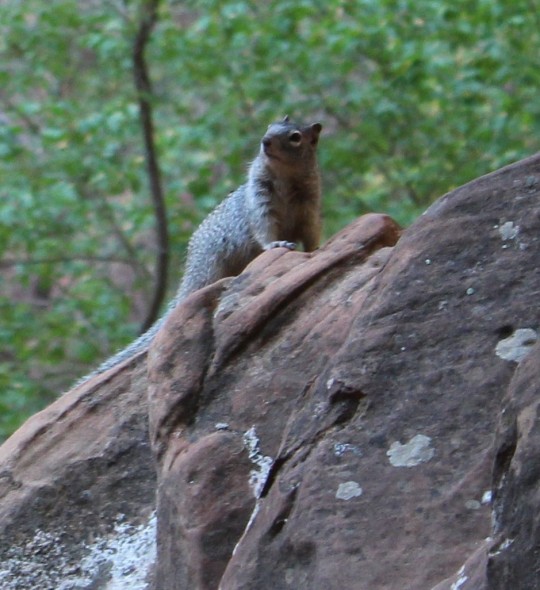

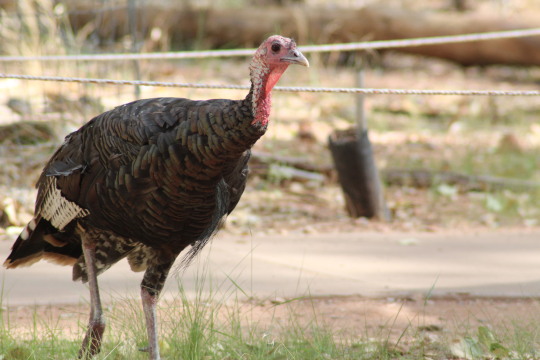


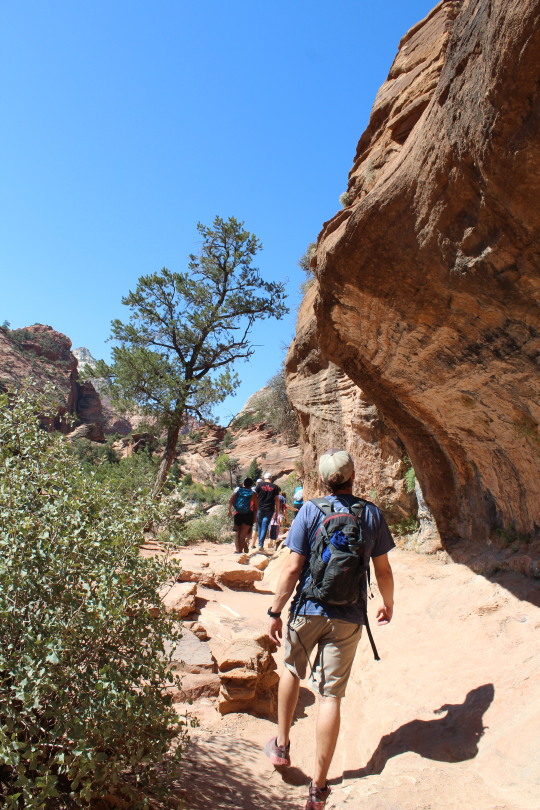

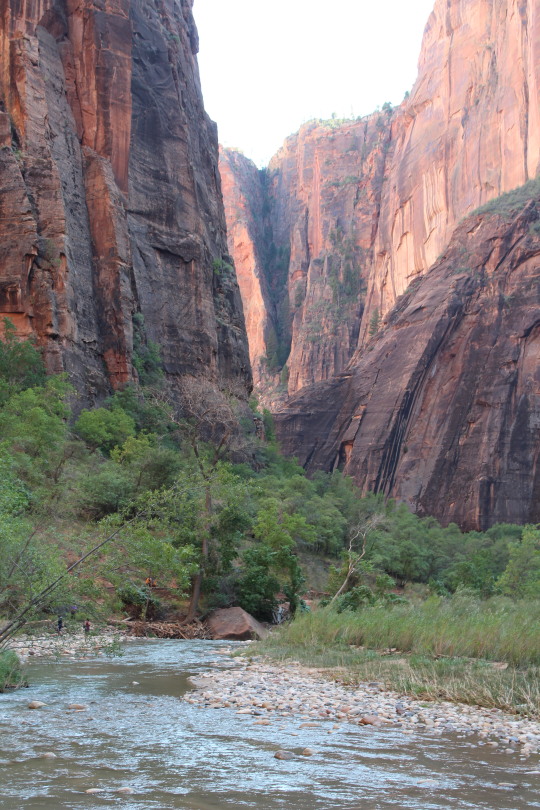

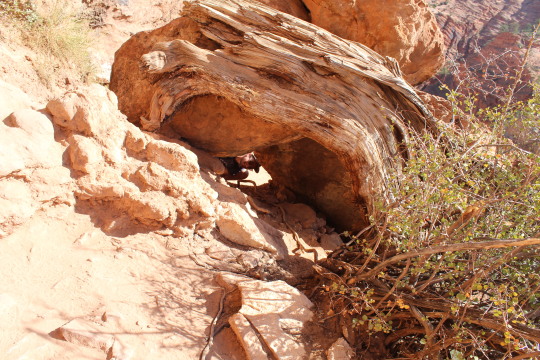
0 notes
Text
Another day in Zion
Day one in Zion, we opted to drive through the part of the park that was open to cars to scout out what we could. We drove the one winding road through the accessible part of the park, including around some steep switchbacks and through a mile-long tunnel. The tunnel had some windows cut in the rock that offered glimpses of the spectacular scenery outside.
We elected to do the East Rim trail to what was reported to be great view from the overlook at the end of the trail.
I am not a big fan of heights and much of the trail is on the edge of cliffs, much without handrails. At one point, I was ready to give up when the trail went out over some wooden planks to go around a rock outcropping. There was quite the drop-off and the boards had seen better days. Zach went forward a little bit and came back to report there was just that one bad area and then it was smoother sailing for as far as he could see. I did make it across.
A bit beyond that flimsy wooden crossing, I came across a woman who was probably in her 60s. She had run out of water in her small water bottle and looked very tired and dehydrated. This would be a tough walk down if you were dizzy and it would be hard for a helicopter or stretcher to carry her off the mountain. I tried to give her some water out of my Camelbak, but was having a hard time milking it out of the mouthpiece so when Zach came up a few minutes later, I asked he had enough to spare to give her some of his. He did. We hiked to the top with her and I gave her some pretzels out of my pack.
There was a great view from the rim when we got to the top. Lots of people were feeding the squirrels. In front of the signs that said not to.
By the time we got back near the park entrance, some parking spots had opened up in one small lot, so we checked out the visitors center then hopped a shuttle to check out the rest of the park.
On the shuttle ride, the driver pointed out the “Three Patriarchs,” three spires, each named after biblical leaders. The plateau nearby is called “The Altar of Sacrifice,” a reference to the sacrifice of Abraham in the Bible. Allegedly, the natives who inhabited this area may have sacrificed young men from their tribe by casting them off this cliff as a way of appeasing their gods. Many Native American tribes believed in human sacrifice. The Aztecs famously would sacrifice the entire team which lost in one of their ball games. In other cultures, young men would volunteer to be tortured to death to appease the gods. For them, dying at age 20 to please the gods, help the tribe and become a legend was worth it—a fair trade in their minds. They traded the 40 or 60 years they might have had remaining for immortality and honor. I wondered: is it really any different than the men who sacrificed themselves at Gettysburg or Normandy—trading their young lives for the good of the tribe.
After covering all of the roads in the park by car or shuttle, we were able to plan our next day in the park—we only had one more day. We opted to do the river walk and scout out The Narrows, which was one of two things Zach really wanted to do in Zion.
The river walk was packed with people. Apparently, all of the people who had gotten into the park free for National Public Lands Day wanted to come here. When we saw an alternate trail heading the same direction, we detoured to it and were glad we did because not only was it more picturesque, closer to the river and dirt rather than paved, there were fewer people, and there were a couple of deer. Our first big-game wildlife encounter!
We talked to a few people who were coming back from hiking The Narrows. Along with Angels Landing, The Narrows is one of the famous features of the park that attract hikers and adventurers. The river along which we had been hiking emerges from a canyon with steep sides. As you hike up the river, the passage narrows, hence the name. You can hike for miles upriver and never be in water that is above the mid-chest. But you have to get about eight miles up the canyon before it gets really narrow and the awesome beauty of this river flowing through a slot canyon is truly apparent.
We assessed the situation. We had each brought a change of shoes specifically for this hike—ones we were willing to let dry for several days after. We had brought hiking sticks—we had been warned the rocks can be slick and it is easy to slip. We had brought little drawstring backpacks so as not to get our full packs wet. And we were going to leave our camera and binoculars in the car and only use our phones for photos and planned to carry them in double Ziplock bags, just in case.
But we weren’t planning on doing this hike today so had not taken any of those preparations and decided it was not worth it to attempt the river now. Zach wanted to at least get a feel for it, so while I sat on a rock, people watching, and enjoying the beautiful scenery of the valley, he climbed down the hill, took off his shoes and socks and played in the river for a while. He reported the water was--as I expected it would be--very cold.
We were considering doing The Narrows the next day, just planning to start earlier and come prepared, but we saw signs warning that there was the possibility of flash floods that day. Rain anywhere upstream can flush the canyon with water too deep and swift to survive. The handy signs in the park also informed how many dozen visitors had perished that way. Likewise for the death toll Angels Landing takes.
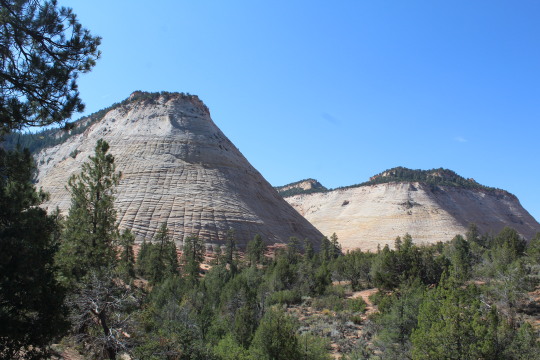
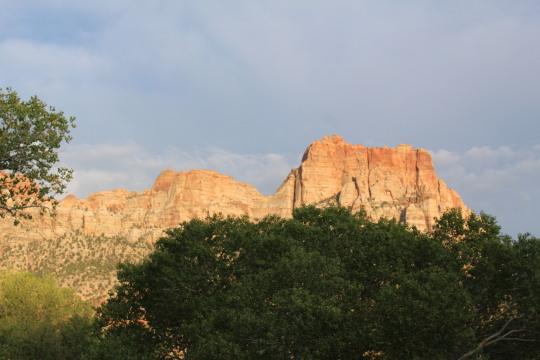
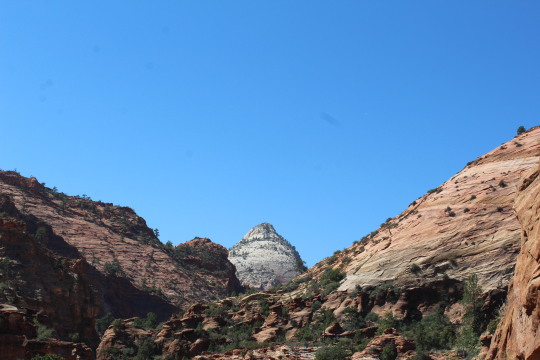
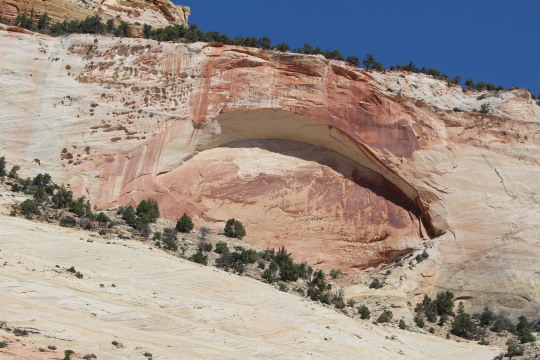


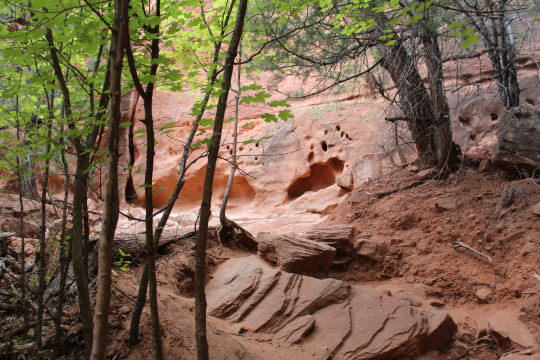
0 notes
Text
Zion
One of the joys/curses of national parks are other people. In Zion we saw a guy with a T-shirt what said, “I’m rednecker than you are” and another man in a T-shirt that said, in a confused muddle of ignorance, “The final variant is communism.” It took us a while to unravel that much stupidity and see if we could make sense of it.
Masks were not much in evidence in most rural areas, although the National Park Service wouldn’t let anyone in their buildings or on shuttle buses without them. Surprisingly, a small gas station in the middle of Wyoming wouldn’t let anyone in the building without a mask. And all of the stores in Jackson, Wyoming required masks and in one we heard a clerk ask a would-be customer to put one on and the man said he wouldn’t adding, “I guess you don’t want my business then!” In the next store where I took a photo of a buffalo wearing a mask, I mentioned the incident to the clerks behind the counter and they said they go through that every day. The funny part is, since every business there seemed firm about their mask policy, the anti-maskers may have a hard time finding a place to shop in town.
Back to Zion…At the visitors Center, there was a sign with the statistics on how many cars used to enter the park and how many parking places there were for them, (about a 10-to-1 ratio), so a few years ago they closed off large parts of the parks to private vehicles and to visit those parts of the park you have to take a shuttle…or have a very long walk.
The mask policy was strictly enforced on the shuttles. They even provide masks to the people who tried to offer the excuse that they didn’t have a mask or had forgotten theirs. One shuttle driver was adamant about riders wearing masks, even giving them to people who lacked them. He said, “We’ve lost two shuttle drivers to covid already!” and the way he said it made Zach and I both think he meant they died, not just were sick.
A group of young men was pretending to look for masks in their packs, clearly planning to stall until the shuttle was moving then not ever putting them on, but the driver angrily yelled over the PA system, “You have two seconds to get a mask on or get off my bus! You can find them and wait for the next shuttle!” Strangely, they found them quickly. I felt sorry for all of the rangers and other park employees who had to put up with this every day. It was interesting to see how many people, after over a year and a half of the pandemic, had still not figured out that the mask should cover the mouth and nose.
Although the shuttle rides were a little risky given the Covid situation, they were the only way to get to much of the park and were good for meeting interesting people and often getting suggestions of things to see or do. A woman in her early 20s was traveling around, by herself, to lots of national parks and gave us some recommendations on Zion. On another shuttle ride, I sat next to a couple, mid-20s, who also had been visiting numerous parks, but he now had to return to the San Francisco Bay Area to make some more money before resuming his travels. His girlfriend, who said almost nothing, was going to continue traveling without him and he’d catch up when he could. We had seen them on the trail to Angels Landing and I said hello to them again at the rest area where I waited for Zach while he finished his trek to the top. We had seen them so often, we started referring to the guy as “Blue Hoodie Boy” for obvious reasons. We did wonder why he was hiking in a sweatshirt with its hood up on such a warm day.
On another shuttle, I found myself next to a guy who had worked for years as a wilderness guide both in and out the national parks. Somehow, we got on the subject of the Native Americans who lived in most of these parks (as everywhere else in North America) before being chased out by the white man.
Side note about white men. We found the plaque in the town square in Jackson Wyoming interesting, it proclaimed that John Colter was the first white man in Wyoming.” Somehow the wording of that just seemed odd.
I mentioned to the wilderness guide that so many of the places in Zion that were occupied by the natives seemed so inhospitable, and I said that seemed even more true of the tribes that lived in Joshua Tree—a dry, desolate National Park in the Mojave Desert. But how would they leave? They couldn’t carry water for more than a few days, and if they started walking, which direction would they go and what would make them think they’d find water or more game or better plants in that direction?
The guide said, “I don’t think it would have occurred to them to leave. As white people, we don’t have much of a sense of place. We move around a lot. But to many native peoples the land was as much a part of them as their family and tribe. They belonged there. For better or worse, they were part of that land. That is why uprooting them as the government did was so cruel. It was not just taking their land; it was taking part of who they were.”
Zach and I had thought it was interesting that these parks honored those early inhabitants, but the plaques and displays seemed to be needing another sentence or two about how, “Hey, yeah it was great you were here and all, but now get off this land so we can make it a park.” I guess their presence wasn’t important enough to let them live there.

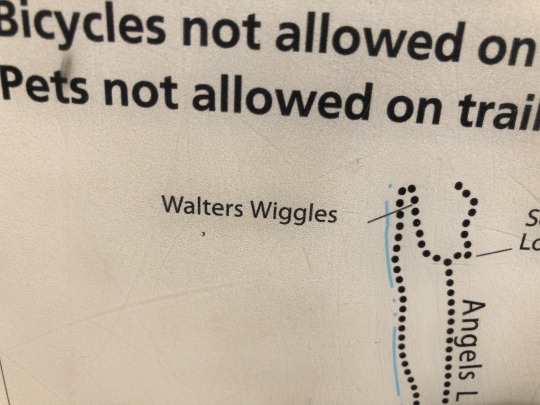
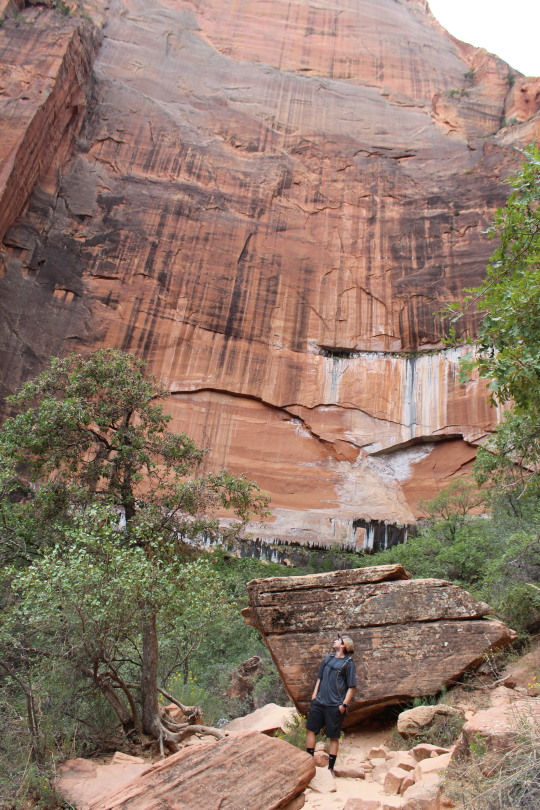

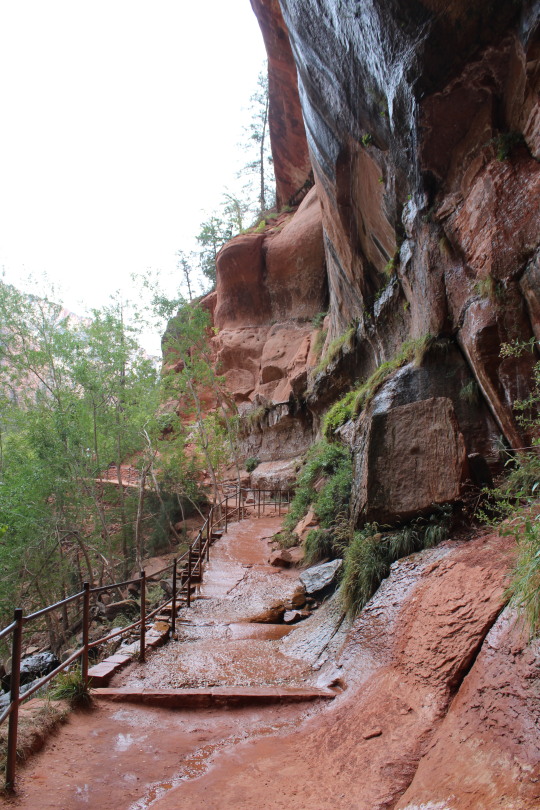

0 notes
Text
Driving to Zion
The day we left St. George was one of driving. We had been warned by the host of the place we were staying in West Yellowstone, Montana, to get north of the greater Salt Lake City area by 3 p.m. or risk being stuck in traffic for hours. The place had a firm cutoff for checking in no later than 10 p.m., so we did get an early start and took turns driving pretty much nonstop through a lot of wide-open space in Utah, keeping the Wasatch Range on our right pretty much the entire time.
We wanted to be sure to clear traffic, and did so with no problem and so wished we had taken a few minutes to at least drive by the capitol and the large temple in Salt Lake. We at least saw the capitol dome from the interstate.
At some point, Zach came up with the idea that we should take a photo of the “Welcome to…” sign as we entered each state. Not always easy at 80 mph on the interstate. And he decided that once we crossed the state line, we should listen to the state song of the place we had just entered. This was not always possible until we could next get a phone signal. There are lots of dead zones in those wide-open spaces. The verdict is that most state songs are horrible. Really, really bad. Like if a fourth grader with no sense of rhythm or poetry was assigned the task of writing it, forgot to do their homework and penned it on the bus on the way to school that morning. California’s state song is particularly bad. Look it up on YouTube. We need to start a movement to change it to “California, Here I come.”
I posted on Facebook that we were traveling through Idaho and a friend messaged me to suggest we hit Upper and Lower Mesa Falls. I am so glad he did. They were some of the most beautiful waterfalls I have ever seen. We got there just before dark and were among a handful of other visitors.
But before we got to the falls, we saw a sign for the Idaho Potato Museum. How can you pass that up in Idaho? A former railroad station had been turned into a shrine to the state’s vegetable. There were singing animatronic potatoes. (I still have the song stuck in my head, “Potato, potato, potato. Potato, Potato, Potato…” dozens of verses of those catchy lyrics. It would actually be a better state song than the one Idaho is currently using.)
There is a huge collection of Potato Head toys and a large assortment of potato mashers. There is the world’s largest pringle. Also on display is the letter from the governor of Idaho to Vice-President Dan Quayle on how to spell potato. There was a potato bar where I had the best baked potato I’ve ever had. But in addition to the fun or goofy stuff, there was a lot of history, very well presented—how the vegetable made it from the new world to become a staple in Europe and became so important that a fungus on the crop in Ireland caused massive starvation and a huge migration to the U.S. There were statistics and maps and other information presented clearly and in an easily digestible way. (See what I did there?) It was quirky, but interesting and we were really glad we stopped.
We had a hard time finding our accommodations in West Yellowstone in the pitch darkness, but we made it by the appointed hour. But, before we explore Yellowstone, let’s back up a moment to Zion.
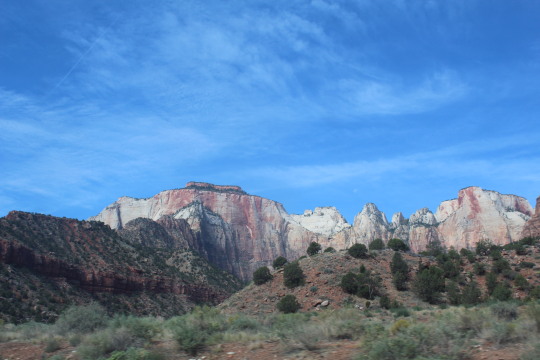
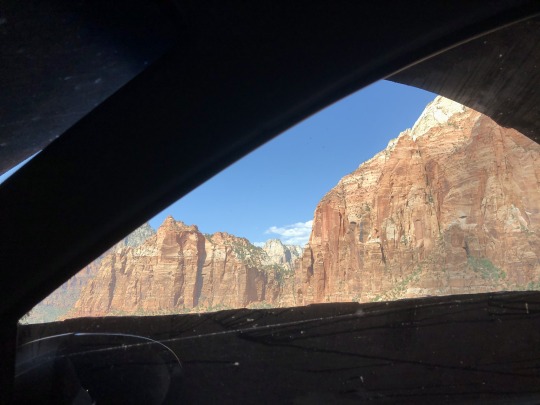







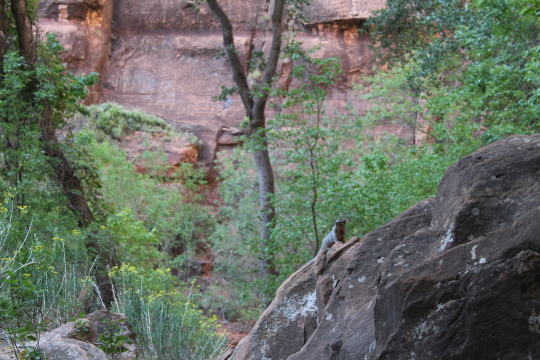
0 notes
Text
The trip was amazing. We covered a lot of territory and saw so much. Just under 4400 miles of driving. Almost ran out of gas. Twice. So much beautiful scenery, incredible wildlife, and lots of wide open spaces—Utah, Wyoming, Colorado, New Mexico, and Arizona all have lots of space. Luckily, Zach loves to drive. I don’t. So he did about 80% of the driving while I played navigator, DJ, and historian.
In addition to the national parks (Zion, Grand Teton, and Yellowstone) which we knew would be fantastic--and were—we found lesser-known national parks and monuments (Petrified Forest and Montezuma’s Well) to be very pretty and interesting along with some other unexpected and wonderful moments—Mesa Falls in Idaho, the quirky Idaho Potato Museum, and the touristy fun of a corner in Winslow, Arizona. There was a flatbed Ford, my Lord!
When I first listed the places I wanted to stop, I had as a goal hitting five of the seven states I need to have visited all 50. I needed Montana, Idaho, Wyoming, the Dakotas, Alaska and Louisiana. But when I realized the scale of those north-central states, I realized it would add a week to the trip to hit the Dakotas. Next time.
I hit more drive-throughs (or, as the sign at the McDonald’s in St. George, Utah said it was, a “Rive Thru”) and ate more fast food on this trip than I have in the last five years combined. We were still avoiding eating indoors so when we couldn’t pack our own meals (we ate more than a few PB&Js on the fly) we’d hit a drive-through and eat in the car in the parking lot. My car needed a thorough cleaning inside and out after all the food and mud and dirt—especially from that dirt road in the national forest outside of Sedona.
We really lucked out on the food. When we did eat out, we chanced upon some really good places. Often bad restaurants can survive a long time in tourist areas since they are not depending on repeat business, but in Jackson Hole, Sedona, West Yellowstone, and every other place we ate we had surprisingly good meals at not unreasonable prices.
It’s going to be hard to record all the adventures and figure out whether to do them chronologically or geographically or by subject. I think the easiest might be a combination. So, I will start at the very beginning, which is a very good place to start. About 664,000 years ago, a super-volcano erupted and…wait, maybe that is going back too far. But I will return to that story in a bit.
On day one, we headed north on I-15 which was to be our home for many hours. We zipped through Las Vegas without stopping—good advice for almost anyone—and on to St. George, Utah, which was the closest accommodations to Zion National Park that we could find. It was a crappy little motel with strange guests, many of whom sat outside their rooms drinking cheap beer and spitting chaw into clear water bottles that they left outside their rooms, not to be picked up the next day. But the noise didn’t go on too late or keep us awake.
I had driven through Zion many years ago on my drive to California, cutting through the park, taking photos, and a short hike. The rocks haven’t changed much. Now I had time explore.
I had laid out most of the Yellowstone, Grand Teton, and Denver parts of the trip, Zach researched and chose the itinerary for most of the Zion visit. But we both failed to do our full homework and ran into some issues. We arrived in Zion on National Public Lands Day—admittance to all parks was free so the place was packed. Our visit to Denver was on Mother Cabrini Day—even any Coloradans we talked to had no idea about this one; and arriving at the Air Force Academy while their famous, beautiful chapel—the reason for our visit--was enclosed in a giant box for renovations. More on the Air Force Academy visit later.
But even with all the people, Zion was beautiful. More on those adventures soon, also.
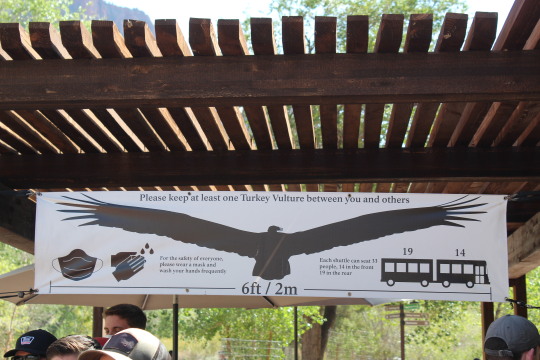

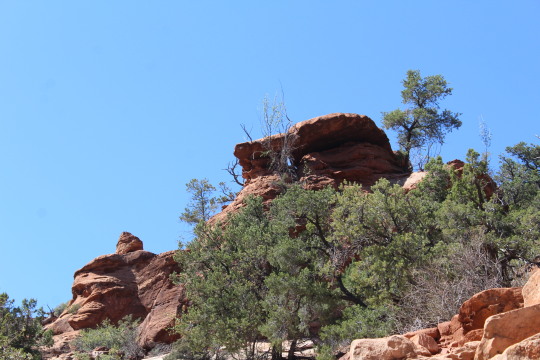

0 notes
Text
I had plans to return to Europe, then Covid hit. Not only were lots of countries turning away tourists, or not allowing them to travel once they arrived somewhere, on top of the risks of being in crowded planes and airports and trains, what is the point of going to Paris if the museums and restaurants are closed? So a friend and I decided to start visiting National Parks, figuring we could stay away from people and not likely catch anything outdoors on hiking trails. These plogs and the accompanying photos will cover some of those adventures. And I will also be sharing some of the plogs from my books and other posts I wrote since covid changed the world. Enjoy and share.

0 notes
Text
Plogging about National Parks
I have been making the rounds of the national parks, even working in Grand Teton this summer. I will be sharing some of my experiences and photos, chronicling my adventures, including hikes, close encounters with bears and elk and meese and side trips to historic sites. Stay tuned for more.
The “plog” in the headline comes from the title of my latest book, “If You Weren’t Here, This Would Not Be Happening: plogs from my life.” During the covid lockdown, I stared writing posts on Facebook that became long enough to be blogs, so I coined the term plog to describe them. Sit back and enjoy!

0 notes
Photo

0 notes
Text
My Latest book:
https://www.amazon.com/Respectful-Leader-Influence-Without-Intimidation/dp/1119281563/ref=asap_bc?ie=UTF8Check out my latest book on Amazon:
0 notes
Text
Goal setting at any age.
Recently, I was asked about goal setting to be quoted in a book on the subject, targeted mainly at senior citizens. But I think this applies at any age. http://www.waltergmeyer.com/goal-setting-age/
0 notes